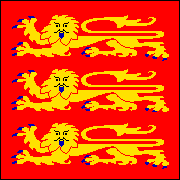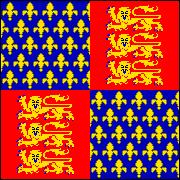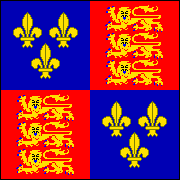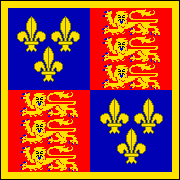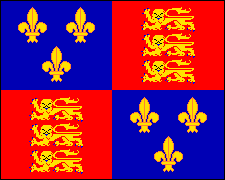|
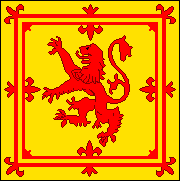
Royal Banner of Scotland
|
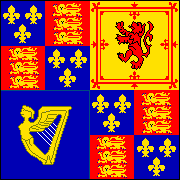
Royal
Standard of James I
As King of England |
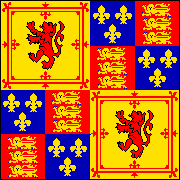
Royal Standard of James I
As King of
Scotland |
|
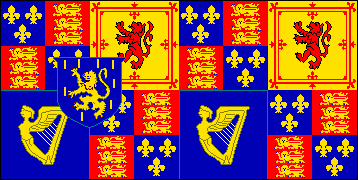
Royal Standard of
William & Mary |
|
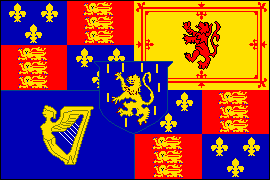
Royal Standard of William III |
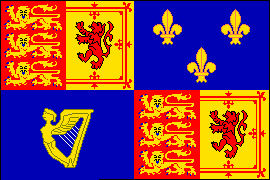
Royal Standard of Anne I |
|
The death of
Queen Elizabeth I in 1603 brought an end to the Tudor dynasty.
The new monarch was James VI of Scotland, who ascended the
English throne as King James I. He was thus the first king of
Great Britain, though technically England and Scotland remained
separate kingdoms, joined only in personal union under James. The
advent of the Stuart dynasty led to the first change in the
England's royal arms since the time of Henry IV, the Tudor arms
being quartered with the royal arms of Scotland and Ireland. The
ancient royal arms of Scotland displayed a red rampant lion
within a frame on a golden yellow field, while those of Ireland
displayed a gold harp, stringed silver, on a blue field. There
also existed for the King's use in Scotland a version of the
royal arms giving Scotland precedence and omitting Ireland.
The Stuart arms remained in use until the deposition of James II in
1688. (During the Period of the English Republic and
Commonwealth, Charles II maintained his claim to the English
throne and continued to bear the Stuart royal arms.)
The Glorious
Revolution of 1688 brought the Dutch Prince William of Orange,
to the English throne as King William III. He was married to
Mary Stuart, daughter of the deposed James II, and until her
death in 1694 they reigned jointly. Thereafter William reigned
alone until his own death in 1702. During the period of joint rule
the Stuart arms were impaled with those of William as King of
England, i.e. the Stuart arms with an escutcheon of William's
arms as Prince or Orange. After Mary's death, William's arms
alone were used. His death brought the Protestant Princess Anne Stuart to the throne. At
first she employed the Stuart arms, but after the 1707 Act of
Union between England and Scotland, the arms were altered to
display Scotland impaled with England, France and Ireland.
These, the first royal arms of the Kingdom of Great Britain,
were also the first in which
France was not given precedence. |
THE HOUSE OF
HANOVER • 1712-1837 |
|
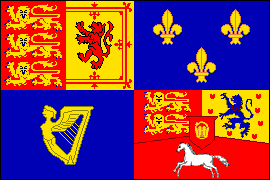
Royal Standard
of George I & II |
|
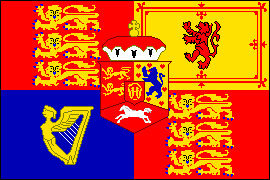
Royal Standard of George III
As Elector of
Hanover |
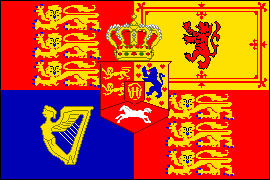
Royal Standard
of George III & IV &
William IV As King of Hanover |
|
Queen Anne died in
1714 with no direct heir and under the terms of the Act of
Settlement of 1714 the crown passed to George Louis, the
Electoral Prince of Hanover in Germany, who became King George
I. His royal arms for Great Britain displayed the arms of
Hanover in the fourth quarter. (George and his four successors retained their German princely titles.) In this form the arms
lasted until 1801. In that year, King George III formerly
renounced Edward III's claim to the French crown, and the French
arms were deleted. The new arms displayed England in the first
and fourth quarters, Scotland in the second quarter and Ireland
in the third quarter, with an escutcheon of the arms
of Hanover under an electoral cap. The cap was changed to a
royal crown in 1816, when Hanover become a kingdom. |
THE HOUSES OF
HANOVER, SAXE-COBURG GOTHA & WINDSOR SINCE 1837 |
|
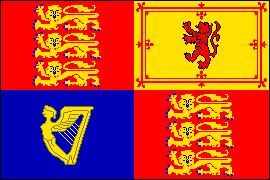
Royal Standard of Queen Victoria |
|
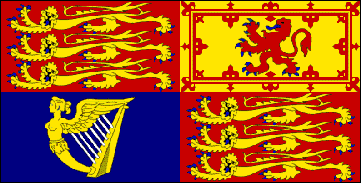
Royal Standard of Charles III in England, Wales &
Northern Ireland |
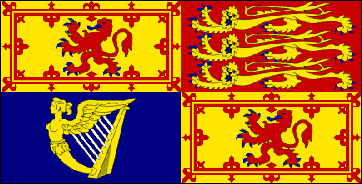
Royal Standard of Charles III in Scotland |
|
King William IV
(reigned 1830-37) was the last British monarch who was also King
of Hanover. Upon his death the throne passed to his niece,
Princess Victoria of Kent. Since according to the Salic Law
prevailing in Germany a woman could not inherit a crown in her
own right, the Kingdom of Hanover passed to George III's fifth
son, Ernest Augustus, Duke of Cumberland. The Hanoverian
escutcheon was removed from the British royal arms, leaving them
in the form still used nowadays. Technically the House of
Hanover's connection to the British throne came to an end with
Queen Victoria's death; thereafter the British royal family was known
as the House of Saxe-Coburg and Gotha. Its name was changed to
the House of Windsor in 1917. (With Britain at war against
Germany, the royal family's German connections had become
something of an embarrassment.) None of these changes affected
the royal arms, however. For the
current Royal Standards of King Charles III a
special shade of crimson is used in place of red.
|
